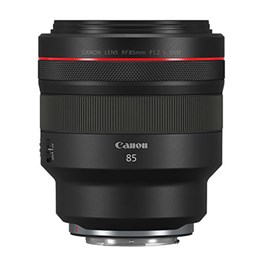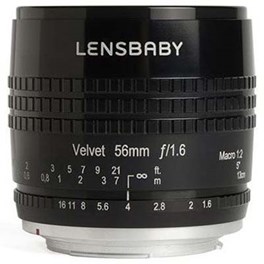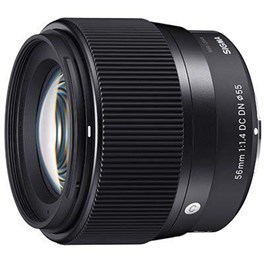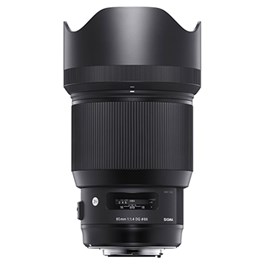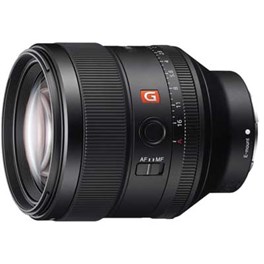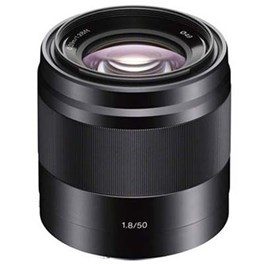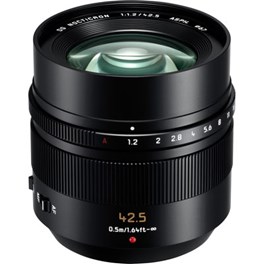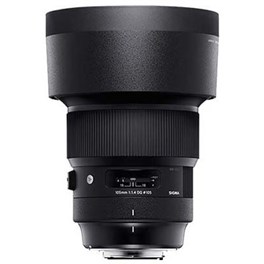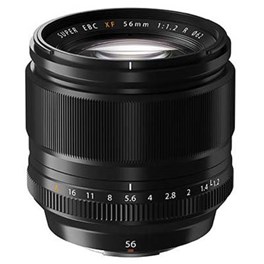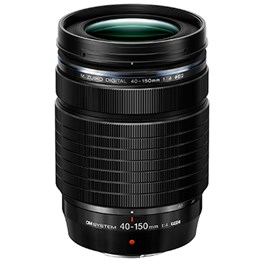
We’ve picked out the best portrait lens for every mount in all the major photography brands. For capturing perfect pictures of people, it’s critically important to get the right lens, one that is going to flatter your subject and render their character in tack-sharp detail.
What key things are we looking for in a good portrait lens? Here are the key specs we’ve kept in mind for this list.
Short telephoto focal length - In general, a longer, narrower focal length is better for portraiture. This is because it narrows and flatters facial features, as opposed to a wide angle, which stretches them out. A short telephoto between 75mm and 110mm is generally regarded as optimal – with longer lenses, you’ll struggle to get anything other than a tight facial crop without standing on the other side of the street from your subject.
It’s also important to consider crop factor if you’re using a smaller sensor. If you’re on full-frame, an 85mm lens will behave like an 85mm lens. However, if you’re using APS-C, you have a crop factor of 1.5x or 1.65x, meaning you should be looking at a 50mm lens to achieve the same effect. On Micro Four Thirds, the crop factor is 2x, meaning a 40mm lens or so is best (Panasonic produces an excellent 42.5mm MFT lens for this exact reason).
Large aperture - The key to portraiture is having a sharp main subject and an artfully blurred background – and for that, you want to slam the lens aperture wide open. The most premium portrait lenses will have ultra-wide apertures of f1.2, which is great if you can get it, but f2 or so will still work well. Be aware though that you have to be very accurate with your focusing when working with such a narrow plane of focus – a camera with Eye AF can be of help here.
Aperture blades - In portraiture, the character of the bokeh in the out-of-focus areas of an image can be very important to the overall look. Ideally, you want nicely rounded points of light – the best for achieving this is a lens with rounded aperture blades, and plenty of them. Most lenses have between 5 and 10, with premium lenses sporting 11 or more. It’s not essential by any means, but nice to have.
Make sure you check out our list of the best digital cameras on the market, which includes many fantastic options for portraiture. And now, let’s crack on with the best lenses for portraits.
Quick Navigation
Best Canon Lens for Portraits
No matter what stripe of Canon user you are, you’re spoiled for choice when it comes to Canon portrait lenses. DSLR shooters can choose from the huge catalogue of EF-mount lenses, which includes plenty of short telephotos with big apertures that are perfect for portraiture. As well as the Canon-made optics, there are also plenty of third-party options from other manufacturers like Samyang, Sigma, Tamron, Lensbaby and more.
Mirrorless users have options too. The Canon RF mount is expanding at pace and includes plenty of Canon-made short telephotos that are specifically optimised for portraiture, with options for a range of budgets. And don’t worry – we haven’t forgotten about Canon’s EOS M mirrorless series. Users of these stylish little mirrorless cameras have plenty of portrait lenses to choose from, made by both Canon and third-party manufacturers. Just remember that EF-M cameras all have APS-C sensors, meaning there’s the crop factor to take into account.
Canon RF 85mm f1.2L USM Lens
The Canon RF 85mm f1.2L USM Lens is the fastest portrait prime in the EOS R system. Great for shooting in low light and isolating the subject from its background, the lens combines a short telephoto focal length with a fast f1.2 aperture to provide an extremely shallow depth of field and incredible sharpness with pleasing bokeh. Canon's RF lenses offer higher quality and speed with a performance optimised for the EOS R camera.
£2,999.00 View
Pros:
- Generous f1.2 aperture
- Incredibly sharp optics
- Fully negates colour aberrations
Cons:
- Designed for pros
This is the fastest lens for the RF system, and it’s specifically optimised to be a perfect portrait prime. The Canon RF 85mm f1.2L USM boasts a sophisticated optical construction of 13 elements in nine groups and includes both Blue Spectrum Refractive (BR) optics and an aspheric lens element. This help to effectively negate colour aberration and distortion, resulting in images of exceptional sharpness and clarity.
That f1.2 aperture makes it possible to produce images with dreamy bokeh and a gorgeously shallow depth of field, perfectly complementing the full-frame sensors of Canon’s flagship EOS R cameras. Of course, this f1.2 lens is built for serious pro photographers – not everyone is going to need this level of sophistication. If your aspirations (and budget) are a little more modest, we’d recommend looking at the Canon RF 85mm f2 IS Macro STM, a sharp lens that punches above its weight for portraiture.
Lensbaby Velvet 56mm f1.6 Lens for Canon RF
The Lensbaby Velvet 56mm f1.6 is a lens that's packed with versatility and creative opportunity. It is primarily a portraiture lens that will produce velvety, glowing and ethereal images, but at the same time, has a 1:2 macro ratio enabling the capture of stunning macro photography. Using Lensbaby's trademark optics, you can capture creative images that are beautifully dream-like images with wider apertures as well as sharp and unique shots as you stop down, giving give a film-like-feel. The true beauty of this lens is that whether you are shooting portraiture or macro work, you can achieve a unique look and feel to you images, reminiscent of classic film cameras and lenses. It match the feel of the images you take, the lens has an old-fashioned design to its barrel exterior - An all-metal body with a clear-anodised finish and engraved aperture/focus markings.
£449.00 View
Pros:
- Works with full-frame and APS-C
- Unique, dreamlike look to images
- Also works well for close-ups
Cons:
- Style may not always be appropriate
- Requires manual focusing
While we could spend a lot of time recommending large-aperture short telephotos (and, spoiler alert: we’re going to), here’s a way to make portraits with a difference. The Lensbaby Velvet 56mm f1.6 Lens allows you to create in-camera dreamlike effects that are full of character. Whack that aperture wide open, and you can have your subject sit in the sharp sweet spot of focusing while surrounding them with a distinctive rounded, velvety bokeh.
It’s not a look that’s going to be appropriate in all situations – you wouldn’t use it for professional headshots. But it’s great for adding a layer of distinctiveness and abstraction to your portraits, and one especially welcome aspect is that you can use it on both full-frame and APS-C Canon DSLRs. On the latter, it’ll deliver an equivalent focal length of about 90mm. If you want something more straightforward for your Canon DSLR, try the Canon EF 85mm F1.4L IS USM or Canon EF 85mm f1.8 USM.
Sigma 56mm f1.4 DC DN Contemporary Lens for Canon M
Sigma’s 56mm f1.4 DC DN Contemporary Lens is characterised by its compact, sleek and lightweight build, along with its exceptional imaging capabilities. The lens is packed with an advanced array of lenses and versatile maximum f1.4 aperture that when combined, rival its cousins in the Sigma Art Series. This mid-telephoto lens is set to impress both enthusiasts and professionals alike.
£419.00 View
Pros:
- Controls well for flare and ghosting
- Portrait-friendly 90mm equivalent focal length
- Sleek, lightweight build
Cons:
- No AF-MF switch
A popular lens available in quite a few mounts, the Sigma 56mm f1.4 DC DN Contemporary Lens is one of the best portraiture options for Canon EOS M users. Once again, the 1.6x crop factor delivers a short telephoto length of just under 90mm (actually 89.6mm, if you’re keeping score), which hits the sweet spot for portraiture and delivers flattering images. Sigma has also added several multi-layer coatings designed to control for flare and ghosting when shooting directly into the light. This means the 56mm f1.4 DC DN Contemporary is a good choice for capturing backlit portraits.
The internal construction of ten premium elements in six groups makes this lens optically very impressive. Even though it carries the “Contemporary” designation, it can produce images on a quality level to rival those of Sigma’s more premium, expressive “Art” lenses, meaning it’s ideal for portrait shooters on a budget.
Best Nikon Lens for Portraits
Nikon users are going to be choosing between a couple of different lines when finding the best Nikon lens for portraits. First, there are the Nikon Z lenses, which are for Z-mount mirrorless users only. Stylish and high-quality, with bags of character, these are excellent lenses for portrait shooters. The Z-mount range also includes lenses from Nikon’s S-Line, a badge of honour that denotes the highest-quality optics. Nikon lenses have to meet a very high standard to receive the ‘S’ designation.
Then there are also the classic F-mount lenses that fit Nikon’s DSLRs. This is a mount that’s been in use for more than half a century, so as you may imagine, there are plenty of choices. DSLR users can only use F-mount lenses, however, Nikon Z mirrorless users have their choice of both, with the FTZ mount adapter enabling the use of F-mount lenses on Z-mount cameras, in most cases with full functionality.
Nikon Z 85mm f1.8 S Lens
The Nikon NIKKOR Z 85mm f/1.8 S is a premium S-Line fast-focusing lens that delivers incredible detail throughout the frame. Whether shooting stills or video, this full-frame mirrorless lens lets photographers portray subjects with astonishing clarity. The Nikon NIKKOR Z 85mm f/1.8 S offers a flattering perspective, breath-taking resolution, stunning bokeh in addition to focus and life like accuracy compensation. This 85mm prime lens is perfect for shooting portraits, wedding and fashion photography as well as street photography and interviews. In a nutshell this lens is the lens for any situation which needs to highlight the human form and can satisfy the needs of a photographer as well as a documentary filmmaker alike.
£799.00 View
Pros:
- Lightweight and agile
- Ultrasharp
- Customisable control ring
Cons:
- f1.8, not f1.4
If you want the sharpest portrait lens for your Z-mount camera, here it is. The Nikon Z 85mm f1.8 S Lens is optically near-perfect, delivering stunning image clarity in laboratory conditions and out in the real world too. While the f1.8 aperture isn’t as wide as others on this list, it’s still better than you’d get from most zooms, and will be fine for creating the sharp delineation between subject and background that portrait shooters are looking for.
This is also a pleasingly lightweight lens, weighing in at just 470g – an f1.2 lens will weigh considerably more than that. We’re also big fans of the customisable control ring around the barrel of the lens. It can be set to manual focus if you prefer to take control of this aspect yourself, but we also enjoy using it as an aperture ring for an SLR-shooting feel.
Sigma 85mm f1.4 Art DG HSM Lens for Nikon F
The Sigma 85mm f1.4 DG HSM Art Lens offers excellent resolving power and minimised chromatic aberration making this the most ideal tool for portrait photography. The beautiful bokeh effect and superbly sharp focus area also contribute to this. The lens brings out the potential of ultra-high megapixel full-frame DSLRs offering 50 megapixel or higher resolution.
£999.00 View
Pros:
- Beautiful quality to out-of-focus areas
- Full-time manual focus override
- Super-sharp even wide-open
Cons:
- Full-frame only
This lens is specifically designed to bring out the most of high-resolution full-frame DSLRs, such as the Nikon D850. The Sigma 85mm f1.4 Art DG HSM Lens is a stunning piece of kit, with a nine-bladed rounded diaphragm that produces gorgeous character in the out-of-focus areas in an image. Also available in Canon EF fit, it has been optimised for portraiture, with precise enough bokeh that you can focus on a subject’s pupils while rendering their eyelashes stylishly out of focus.
The Sigma 85mm f1/4 Art is super-sharp, even when set to its maximum aperture. We also appreciate the addition of a full-time manual focus override switch, meaning you can take over focusing duties whenever you want to, in case the camera isn’t precise enough for your liking. One thing to note, however, is that this lens isn’t suitable for Nikon’s DX-format DSLRs – it’s full-frame (FX) only. Crop-sensor DSLR users may want to consider the Nikon 50mm f1.8 G AF-S, which will deliver an equivalent focal length of 75mm.
Zeiss 85mm f1.4 Milvus ZF.2 Lens - Nikon F Mount
The subject stands out with astounding clarity against a background that vanishes masterfully in the soft bokeh of the image composition. The highly precise, manual focus of the Zeiss 85mm f1.4 Milvus ZE lens lets the observer experience every single detail.
£1,700.00 View
Pros:
- Incredible detail resolution
- Sublime soft bokeh
Cons:
- Manual focus only
- Quite sizeable
You can’t argue with a Zeiss lens. These optics may be only available for certain mounts and may be manual focus only, but the distinctive character of Zeiss Milvus lenses has been winning over photographers for quite some time now. The Zeiss 85mm f1.4 Milvus ZF.2 is an absolute stunner, able to produce a superb separation between subject and background that simply has to be seen to be appreciated.
It’s a pro-level lens, designed for those who need the best in terms of quality. It’s not a small lens, weighing in at a little more than a kilogram, but the balancing is pretty well spot on, and it shouldn’t feel too out-of-whack on a DSLR (the lens also comes in Canon fit). Also, in a nice touch, the aperture ring and focusing ring turn in the correct direction for Nikon users, which sounds like a small point, but can be a big pain if you’re regularly switching between lenses.
Best Sony Lens for Portraits
Sony cameras are ideal for portraits, especially the high-resolution sensors of the Alpha 7 series. As such, it’s important to pick up a lens that can make the most of all those pixels and deliver an image of unparalleled sharpness – fortunately, Sony users are spoiled for choice in this department. The Sony G Master lenses, in particular, are absolutely spectacular – they’re designed specifically for full-frame cameras, and represent some of the best optical technology Sony has to offer.
But let’s not count out the APS-C mirrorless cameras from Sony, which are also excellent for portraits. There are plenty of useful lenses around the 50mm mark (remember the crop factor), including multiple options from third-party manufacturers. Sony has had its E-mount freely available to other lens makers for quite some time now, so a real stable has been built up. The only question is – which to choose?
Sony FE 85mm f1.4 G Master Lens
The Sony FE 85mm F1.4 GM lens is the perfect prime for serious photographers looking to capture beautifully sharp portraits with a soft, visually appealing bokeh backdrop. Designed specifically for full-frame, the lens sits in the company's G Master (GM) brand of lenses, which represents the finest and most impressive group of lenses that Sony has ever made. Designed and built to the strictest precision standards, this lens offers magnificent imaging performance throughout the frame, right up to its widest f1.4 aperture setting. A focus mode switch, focus hold button, and aperture ring with switchable click stops provide professional control for a wide range of shooting situations.
£1,499.00 View
Pros:
- Rock-solid build quality
- Beautifully smooth backgrounds
- Incredible precision and sharpness
Cons:
- Full-frame only
- On the heavy side
The Sony FE 85mm f1.4 G Master Lens is the memory of Sony’s top-tier family that has been designed from the ground up to deliver perfect portraits. A lens needs to pass some pretty stringent optical tests to receive the “G Master” designation, and as such, the Sony FE 85mm f1.4 G Master produces absolutely top-notch sharpness throughout the entire frame, even when opened up to f1.4. The transition from the sharpest areas of the image to the artfully blurred background is beautiful. This is simply a remarkable lens.
G Master lenses are optimised for full-frame only, so this is one for users of main-line Alpha cameras like the A7R V or A7 IV. It is definitely heavy for a lens of this type, weighing in at 820g, so bear that in mind if you’re planning a prolonged shoot.
Sony E 50mm f1.8 OSS Lens Black
Stylish and lightweight, the Sony E50mm f1.8 OSS Lens is a fast prime lens with a large f1.8 aperture designed to perfectly complement Sony's E-mount APS-C compact system cameras. The bright f1.8 aperture with shallow depth of field allows you to capture the detail and create a smooth background bokeh effect. The built-in Optical SteadyShot (OSS) is ideal for taking atmospheric handheld portraits without flash in dim light. Direct manual focus disengages the AF motor for precise, fine manual focusing control. The Sony E50mm lens is ideal for portraits, travel, shooting handheld in low light and is a great way to push your creative boundaries.
£249.00 View
Pros:
- Optimised specifically for APS-C
- Optical SteadyShot stabilisation
Cons:
- No weather-sealing
- Manual focus is electronic, not mechanical
Full-frame lenses often feel quite overbalanced on APS-C cameras, so it’s always preferable to get a lens that has been specifically designed for crop-sensor cameras. The Sony E 50mm f1.8 OSS is just such a lens, and balances really nicely with Sony-made APS-C cameras like the A6000 or the A6400. It has plenty of attractive features for portrait shooters too – Optical SteadyShot (OSS) stabilisation is really handy, as it means you can keep on shooting handheld even once the light gets low. If you’ve always had a hankering to capture some atmospheric portraits at the tail end of dusk, this could be a great option.
Just keep an eye on the forecast – the Sony E 50mm f1.8 OSS isn’t weather sealed. Also, while it does offer manual focusing, the mechanism is electronic rather than mechanical, which doesn’t quite have the same tactile feel.
Best Panasonic Lens for Portraits
With Panasonic portrait lenses, we’re dealing with two systems with very different sensor sizes. The Lumix G cameras use Micro Four Thirds lenses and Four Thirds sensors, which are smaller than the APS-C sensors found in smaller mirrorless cameras and DSLRs. This means a more significant crop factor – whereas APS-C sensors incur a 1.5x crop factor, Micro Four Thirds incurs a 2x crop factor. This means that a lens’ focal length effectively doubles, and thus for our portrait-shooting purposes, we should be looking around the 40mm mark.
On the other hand, the newer Panasonic Lumix S cameras have full-frame sensors, meaning what you see is what you get when it comes to focal length. Lumix S cameras use the “L” lens mount, in alliance with Sigma and Leica, meaning there are a lot of fantastic lenses to choose from. Here are our top picks for both systems.
Panasonic 42.5mm f1.2 ASPH Leica DG Nocticron OIS Lens
The Panasonic f1.2 ASPH Leica DG Nocticron O.I.S. Lens for the Micro Four Thirds system is a fast portrait lens with maximum f1.2 aperture and Optical Image Stabilisation. The aperture ring on the lens barrel allows direct, intuitive control over aperture settings so you don't have to take your eye off the subject and potentially miss the shot.
£1,149.00 View
Pros:
- Generous f1.2 aperture
- Bang-on 85mm equivalent focal length
- All-metal construction
Cons:
- On the heavy side for MFT
- No weather sealing
You can see the maths that has been done here. At first glance, a lens at 42.5mm sounds a bit weirdly specific, but double it up to account for the crop factor, and you get our old friend – 85mm equivalent. The Panasonic 42.5mm f1.2 ASPH Leica DG Nocticron OIS is a crisply sharp and solidly constructed lens – we particularly like the tactile aperture ring, which helps keep you in the moment when adjusting settings.
With a nine-bladed diaphragm and an f1.2 aperture, the Panasonic 42.5mm f1.2 ASPH Leica DG Nocticron OIS is adept at creating smooth, pleasing bokeh in the defocused areas of images. The Leica-made optics deliver exceptional sharpness, and having Optical Image Stabilisation (OIS) on board helps keep images sharp when you’re shooting hand-held and the light starts to drop. This lens is a good few years old now, but it still delivers the goods when it comes to portraiture.
Sigma 105mm f1.4 DG HSM Art Lens for L-Mount
The Sigma 105mm f1.4 DG HSM Art Lens - L-Mount has been crowned the "bokeh master" making it ideal for portrait photography. It offers incredibly high image resolution and is designed for use with full-frame sensors. In addition to this, this lens also offers the longest focal length that the SIGMA Art range has to offer.
£1,299.00 View
Pros:
- Near-perfect bokeh smoothness
- Weather sealed
- Practically non-existent chromatic aberration
Cons:
- Physically very heavy
L-mount users have plenty to choose from when it comes to portrait lenses, but we’re going to opt for one of the more interesting lenses we’ve seen – the Sigma 105mm f1.4 DG HSM Art Lens. This lens has a longer focal length than the others we’ve seen on this list, so you’re going to be a little tighter on your subject, but it’s still well within tolerances for stunning portraiture. There are weather seals on the barrel too, so you can shoot out on location without fear.
Sharpness is inhumanly good, even when the lens is wide open, and we have to praise the near-perfect circularity of the bokeh produced by this lens. It’s absolutely stunning. This lens has real character, producing stunning images in pretty much any situation, and is an outstanding choice for a portrait shoot. Be warned though – weighing in at more than 1.6kg, it is not a lightweight lens.
Best Fujifilm Lens for Portraits
With Fujifilm cameras, you have plenty of interesting choices. Those using X-mount mirrorless cameras – likely most of you – will have the full suite of X lenses to choose from. These large-aperture, ultra-sharp lenses are absolutely fantastic, full of optical character that’s perfect for portraiture. The X-series cameras use APS-C sensors, meaning we’re once again working with a 1.5x crop factor, and are therefore shopping around for 50-60mm lenses.
However, a Fujifilm user may instead be shooting with one of the firm’s fantastic GFX mirrorless medium format cameras. These big-sensor models are terrific for producing portraits full of depth and tonality. However, in this case, as the sensor is larger than full-frame, the crop factor works in the other direction. A lens mounted on medium format will produce a field of view equivalent to 0.8x the stated focal length – so a 100mm lens behaves like an 80mm lens.
We’ve picked a lens for each mount in this section of the guide.
Fujifilm XF 56mm f1.2 R Lens
The perfect portraiture lens, the Fujifilm 56mm f1.2 R XF Fujinon Lens offers a 85mm-equivalent focal length and a super-fast maximum aperture of f1.2. This lens is capable of great things; it's stunningly sharp, bright, has incredible AF acquisition and is at home in light or dark conditions. Its control of depth of field and subject isolation would be note-worthy by any photographer's standards.
£549.00 View
Pros:
- Sophisticated construction delivers outstanding images
- 11-blade diaphragm
- Stunning bokeh quality
Cons:
- No stabilisation
There are a fair few X-mount lenses we could have nominated here, but ultimately we had to give it to the Fujifilm XF 56mm f1.2 R WR. A second-generation refinement of a truly outstanding lens, the Fujifilm XF 56mm f1.2 R WR is constructed internally of 13 elements in eight groups, and is the first X-mount lens to feature an 11-bladed diaphragm. This means it gives outstanding bokeh quality, with perfectly rounded points of light, and you don’t necessarily have to open it all the way up to get them – it should still be the case around f4 or f5.6.
Weather sealed, with well-engineered handling that includes a well-sized aperture ring, the Fujifilm XF 56mm f1.2 R WR is a pleasure to use. The shallow depth of field effects it can produce are quite unlike anything else on the market, and make a compelling argument for the X system as being one of the best choices portrait photographers can make.
Fujifilm GF 110mm f2 R LM WR Lens
The GF 110mm F/2 R LM WR is one of Fujifilm's newest lenses for their GFX 50S medium format camera. Equivalent to 87mm when mounted on the camera, this medium telephoto lens is ideal for portraits. A fast aperture of f/2 offers rich bokeh that is characteristic of medium format photography, while a locking mechanism prevents unintentional movements of the aperture ring while in use.
£2,599.00 View
Pros:
- Rich, beautiful bokeh
- Gorgeous colours and contrast
- Decent close-focusing capabilities
Cons:
- Maxes out at f2
- No stabilisation
If you’re using medium-format GFX cameras, then the Fujifilm GF 110mm f2 R LM WR is a no-brainer of a choice for portraiture. When the difference in sensor size is taken into account, it delivers an equivalent focal length of about 87mm, putting it right in the portraiture sweet spot, and image quality is absolutely outstanding. With punchy colours and impressive contrast, this really is a lens that’ll make anyone look their best.
The GF 110mm lens is – you guessed it – very, very sharp. If a lens is going to have to deal with 100MP sensors, this is something of a given. And yet, a nice aspect for portrait photographers is that when you open it up to the maximum aperture, it manages to produce a sensible level of softness on skin, meaning you’re not going to have to devote hours and hours of your life to retouching.
Best OM-System Lens for Portraits
We’re returning to the Micro Four Thirds standard as we round out our guide with the best portrait lenses for Olympus users. However, we once again have a choice to consider, as this is really a category made up of two parts – Olympus lenses, and lenses branded OM SYSTEM, following the imaging brand’s sale to OM Digital Solutions.
We wouldn’t worry about it too much – both types will work with the same cameras, after all. Whether you’re using an Olympus camera, and OM SYSTEM camera, or a Panasonic camera for that matter, all these lenses will deliver fantastic results for portraiture – that’s the point of Micro Four Thirds, after all! So, we’ve taken a look across the whole Olympus and OM SYSTEM range, and come up with the lenses we reckon deliver the best results for portrait shooters. And remember the 2x Micro Four Thirds crop factor – so when we talk about a 40mm lens, we really mean an 80mm lens.
Olympus M.Zuiko Digital ED 25mm f1.2 PRO Lens
Incorporating the latest optical technology to deliver edge-to-edge resolution results, the Olympus 25mm f/1.2 M.Zuiko PRO Lens features exceptional low-light capabilities with unrivalled sharpness and clarity. Splash-, dust-, and freezeproof, this rugged lens produces images with stunning bokeh due to its fast f/1.2 aperture construction. Furthermore, it boasts a super-fast autofocus system.
£1,099.00 View
Pros:
- Hard-wearing and durable
- f1.2 delivers gorgeous bokeh
- Sophisticated coatings reduce flare
Cons:
- On the big side for MFT
The Olympus M.Zuiko Digital ED 25mm f1.2 PRO Lens is a lens that’s pretty hard to fault, especially if you’re planning on shooting portraits. Its 25mm focal range provides a 50mm full-frame equivalent view which is perfect for portraiture. And while it is on the pricey side, we’d say it’s worth it for what you get: a super-sharp lens that makes the most of its f1.2 aperture to deliver outstanding bokeh. The body is weather-sealed, the autofocus is swift, and the element coatings control brilliantly for ghosting and flare. Like we said – there’s not much to fault here!
OM SYSTEM M.Zuiko 40-150mm f4 PRO Lens
OM System’s M.Zuiko 40-150mm f4 Pro Lens is a true marvel of photographic design and engineering. This lens, which offers a 35mm full-frame equivalent focal length of 80mm to 300mm, is one of the World’s most compact and lightweight telephoto lenses ever. It is packed with premium lenses and components that in turn offer exceptional image quality, handling and overall performance.
£749.00 View
Pros:
- Versatile focal range
- IP53 waterproofing
- Lightweight for a zoom of its kind
Cons:
- f4 will be limiting for some
- Latter end of its focal range is not too useful for portraits
We’ve generally steered clear of zooms in this guide, as primes tend to be better suited for portraiture. If however, you think you might like the flexibility of a zoom lens, we really rate the relatively new OM SYSTEM M.Zuiko 40-150mm f4 PRO. It covers an equivalent focal range of 80-300mm, meaning you’ll likely stay around the wide end for portrait shooting – in most situations, 200mm or above is going to be tighter than you need.
However, with pin-sharp optics and IP53 weather-sealing, the OM SYSTEM M.Zuiko 40-150mm f4 PRO is going to be a really compelling choice for shooting location portraits. It also has the proprietary OM System ZERO (Zuiko Extra-low Reflection Optical) element coatings that are highly effective for controlling ghosting and flare, making it another great choice for shooting into the light. If you can live with a maximum aperture of f4, then you’ll have a ball with this lens.
FAQs
What is a portrait lens?
A portrait lens is a type of camera lens designed specifically for taking portraits. They tend to have a longer focal length and wide aperture that helps to create a shallow depth of field and separate the subject from the background.
What is the best focal length for portraits?
Typically, a 50mm lens is considered the standard for portrait photography as it provides a natural field of view that closely resembles human vision. However, lenses with longer focal lengths such as 85mm, 100mm, and 135mm are also popular for portraits as they allow for a tighter crop and greater subject separation.
What is the ideal aperture for portraits?
The ideal aperture for portraits is often between f2.8 to f5.6. These settings will provide a shallow depth of field and help to blur the background. This helps to draw attention to the subject and isolate them from the surrounding environment.
Do I need a prime lens for portraits?
While zoom lenses can be used for portraits, prime lenses are often preferred for their wider maximum apertures and sharper image quality. A prime lens is also easier to use as it only has one focal length, which makes it simpler to compose shots.
What is the difference between a full-frame and a crop-sensor lens for portraits?
The main difference between full-frame and crop-sensor lenses is their field of view. Lenses designed for full-frame cameras will produce a wider field of view than lenses designed for crop-sensor cameras with the same focal length. This means that a 50mm lens on a full-frame camera will produce a wider field of view than a 50mm lens on a crop-sensor camera.
What is bokeh in portraits?
Bokeh refers to the out-of-focus areas in a photograph. A shallow depth of field and a wide aperture create a pleasing bokeh, which can help to separate the subject from the background and make portraits more visually appealing.
How do we decide?
Our in-house photography experts, store staff and partners all work collaboratively to pour over these guides. The cameras and equipment recommended in our guides are based on their personal opinion, empirical experience and of course, feedback from our customers.
We way up price, features, quality and the all-important 'je ne sais quoi' to make sure we recommend products that will delight and inspire.
If you would like more advice on any purchase our contact centre staff are here to help. Alternatively, you can reach us via email or social media.
And don't forget. If you were to purchase anything based on our recommendations you'll be covered by our full returns policy
Buying Guides

